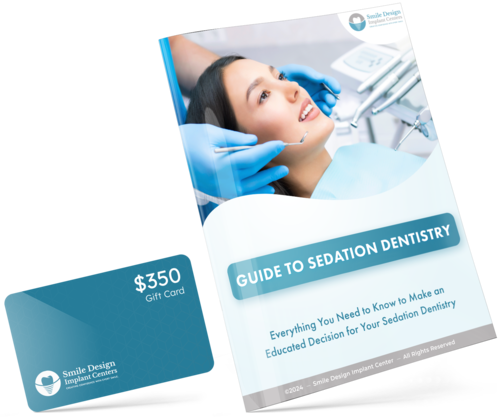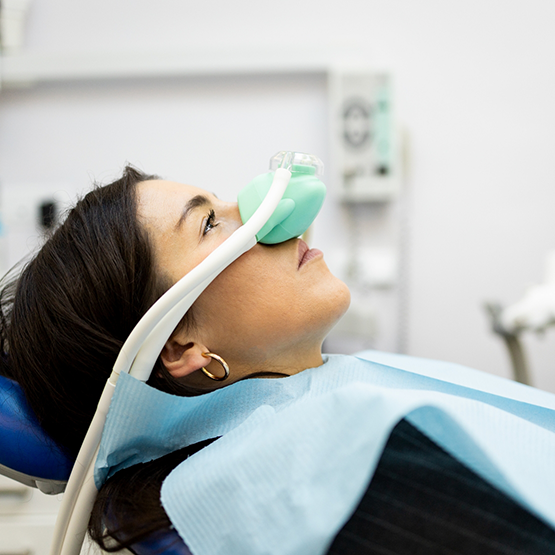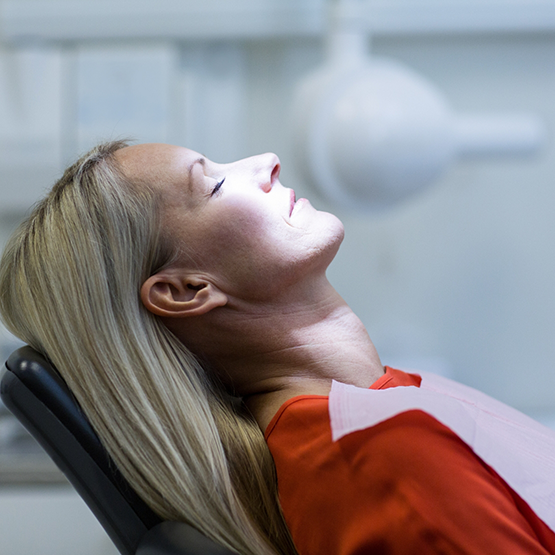These days, it’s pretty common to feel reluctant, or even frightened, about visiting the dentist; it’s estimated that 15% of people worldwide suffer from this “dentophobia,” or debilitating fear of dental treatment. But when this condition causes you to neglect your smile or skip dental visits, it becomes a big problem! That’s why our team is excited to offer sedation dentistry; it’s a surefire way to promote a positive and comfortable experience in the dental chair. To learn more about how we can utilize sedation dentistry in Reno to make your next visit the smoothest appointment of your life, just give our office a call today!
Why Choose Smile Design Implant Centers for Sedation Dentistry?
- Comfortable Office with Patient-Friendly Amenities
- Accommodating and Qualified Dental Staff
- Numerous Sedation Options Available

The Guide Will Show You
- Sedation Options
- Eligbility Factors
- Sedation FAQ's
- And More!
IV Sedation
IV sedation is the deepest form of conscious sedation available in a dental setting, and it involves the sedatives being delivered directly into your bloodstream through an IV line. During your procedure, your heart rate, blood pressure, and oxygen levels are carefully monitored, and the medication dosage can be adjusted at any point (if necessary). All in all, most people who receive IV sedation have little memory of their treatment, making it a great option for patients with extreme dental anxiety or those undergoing lengthy or complex procedures.
Oral Conscious Sedation
Oral conscious sedation is normally recommended for patients who are unable to benefit from nitrous oxide, those with moderate dental-related anxiety, and those who are undergoing more complex procedures. It involves taking prescribed medicine before your appointment so that by the time you’re seated for treatment, you’ve started feeling its effects. You’ll still be conscious and responsive, but you’ll feel totally relaxed and at ease, albeit also a little drowsy.
Nitrous Oxide Sedation
Often referred to as “laughing gas,” nitrous oxide has seen use in modern medicine for quite some time now, offering patients a way to comfortably endure virtually all types of dental treatments. Despite its name, it doesn’t cause patients to laugh; rather, it causes them to enter a euphoric and calm state that makes dental care easier for all parties involved. Patients are still conscious and responsive to verbal and physical stimuli. It’s among the best ways of addressing dentophobia and is generally quite safe and effective for all patients.
Benefits of Sedation Dentistry
Some patients can benefit from sedation during dental procedures. Here are some common benefits:
- It allows them to relax so they can receive treatment without experiencing any stress or anxiety.
- It helps them remain still and comfortable during treatment.
- During the procedure, the patient remains awake but feels less pain. This makes it possible for the dentist to complete treatments that otherwise would not be possible due to a patient’s physical discomfort and pain.
- The patient is still able to breathe independently, which means that they have no risk of asphyxiation.
- Certain forms of sedation are safe to use in combination with local anesthesia, allowing the dentist to provide even more effective pain management for patients. For example, nitrous oxide can be combined with local anesthetics to reduce the pain associated with an injection.
- Sedation promotes faster healing after a dental procedure. That’s especially important for patients who need to undergo a complex treatment plan that involves several appointments. With sedation, they can undergo more of the procedures they need in a single visit without requiring additional appointments in the future.
- There is very little to no downtime after using sedation during a dental appointment. Patients can return to their normal activities immediately after the procedure is completed.
- Patients who have certain medical conditions require the use of sedation because the treatment is invasive. They should not put off dental treatment because they fear they will not be able to cope with the pain or anxiety of the procedure.
- Sedation allows dentists to treat patients who are very young or very old. Children who haven’t visited a dentist before may be fearful and require the help of sedatives. Older adults may have difficulty staying still for long periods of time. Dentists may use sedation to help them perform necessary procedures without causing unnecessary pain and trauma to the patient.
Sedation Dentistry FAQs
How long the effects linger depends largely on the type of dental sedation you choose. For example, the effects of oral conscious sedation often last for the rest of the day, which is why patients are instructed to arrange for a trusted adult to drive them home, to avoid operating heavy machinery, and to focus on resting. In contrast, the effects of nitrous oxide dissipate within a matter of minutes. So, you don’t have to make any special arrangements – you can resume your usual routine right after your appointment!
Even with more mild forms of sedation dentistry, like nitrous oxide, there’s a good chance that you won’t remember much about your time in the treatment chair. This memory loss effect has a positive, unexpected outcome for many patients: it helps decrease their dental-related anxiety moving forward. So, if you struggle with stress, worry, or fear surrounding dental care, don’t hesitate to schedule a consultation with us to find out if you’re a candidate for dental sedation. There’s a good chance that it’s the solution you’ve been looking for!
There are some cases where sedation dentistry is covered, like if you have a disability that makes it impossible to get the preventive or restorative care you need without it. That said, it is considered a luxury in most cases and, therefore, is an expense paid for out-of-pocket. If you have any questions pertaining to your coverage, don’t hesitate to reach out to your provider directly or read through the fine print on your plan. You can also give us a call. Once we have your membership information, we can review your benefits and provide you with an estimate of your out-of-pocket expenses.
If you have been putting off getting the care you need – whether it’s your six-month checkup or a root canal – sedation dentistry is worth the investment. Not only will it ensure that you don’t feel any anxiety in the treatment chair, but it will also create a more positive association with dental care moving forward. So, even if the anxiety, stress, or worry you feel seems minor, don’t hesitate to talk to us about the calming solutions we offer. We’d be happy to answer any questions you have and help you determine which one is ideal for you.
There is a higher risk of nausea with stronger forms of sedation, like oral conscious sedation. For that reason, patients are typically asked not to eat anything prior to their appointment. With nitrous oxide, that’s typically not a concern. That said, if you struggle with feeling nauseous, don’t hesitate to let us know so we can work with you to find a solution.
No, dental sedation won’t make you reveal any deep, dark secrets. In fact, it oftentimes has such a calming effect that patients doze off!




